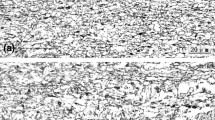Abstract
The mechanical and physical properties of X70 pipeline steels produced in France and Japan are comprehensively studied using tensile and impact bending tests, analysis of the fracture reliefs of specimens, and the estimation of acoustic emission parameters, the attenuation coefficient of longitudinal ultrasonic waves, and the residual magnetic field intensity. A correlation between the mechanical and physical characteristics during tensile tests is revealed. After long-term operation, the yield strength and the ultimate tensile strength are shown to decrease and the plasticity and impact characteristics are shown to increase in comparison with the initial values from pipelines sertificates for both studied steels. The predominant mechanism of these changes is associated with the presence of a large number of delaminations, which cause fracture energy dissipation and hide the true picture of changes in the estimated strength characteristics.










Similar content being viewed by others
REFERENCES
H. Nykyforchyn, O. Tsyrulnyk, O. Zvirko, and M. Hredil, “Role of hydrogen in operational degradation of pipeline steel,” Procedia Structural Integrity 28, 896–902 (2020).
N. A. Makhutov, V. N. Permyakov, Yu. A. Kravtsova, and L. R. Botvina, “Estimation of the state of the product pipeline after its long-term operation,” Zavod. Lab. 73 (2), 54–60 (2007).
A. Ya. Krasovskii, I. V. Lokhman, and I. V. Orynyak, “Estimation of the residual resource of a main stress-corrosion-damaged pipeline,” in Proceedings of International Conference on Residual Resource and Problems of Modernization of Main and Field Pipeline Systems (Kiev, 2011), pp. 1–12.
G. A. Filippov, O. V. Livanova, O. N. Chevskaya, and I. P. Shabalov, “Pipeline steel degradation during operation and brittle failure resistance,” Metallurgist 57 (7, 8), 612–622 (2013).
E. I. Kryzhanivs’kyi and H. M. Nykyforchyn, “Specific features of hydrogen induced corrosion degradation of steels of gas and oil pipelines and oil storage reservoirs,” Mater. Sci. 47 (2), 127–136 (2011).
M. Hredil, H. Krechkovska, O. Student, and I. Kurnat, “Fractographic features of long term operated gas pipeline steels fracture under impact loading,” Procedia Structural Integrity 21, 166–172 (2019).
S. V. Panin, V. I. Vlasov, P. O. Marushchak, A. V. Eremina, A. V. Byakova, F. Berto, A. Yu. Vinogradov, A. S. Syromyatnikova, R. Stankevich, “Influence of long-term operation on structure, fatigue durability and impact toughness of 09Mn2Si pipeline steel,” Procedia Structural Integrity 5, 401–408 (2017).
A. V. Nokhrin and V. N. Chuvil’deev, “Aging of gas-main pipeline steels,” Vestn. Nizhegorod. Univ., No. 5 (2), 171–180 (2010).
I. Yu. Pyshmintsev, A. B. Arabei, V. M. Farber, V. A. Khotinov, and N. V. Lezhnin, “Laboratory criteria of crack resistance of high-strength steels for gas-main pipeline steels,” Fiz. Met. Metalloved. 113 (4), 433–439 (2012).
L. A. Abd-Elhady, H. E. M. Sallam, and M. A. Mubaraki, “Failure analysis of composite repaired pipelines with an inclined crack under static internal pressure,” Procedia Structural Integrity 5, 123–130 (2017).
T. Chuluunbat, Cheng Lu, A. Kostryshev, and K. Tieu, “Investigation of X70 line pipe steel fracture during single edge-notched tensile testing using acoustic emission monitoring,” Mater. Sci. Eng., A 640, 471–479 (2015).
V. V. Koshevoi, I. M. Romanishin, R. I. Romanishin, and R. V. Sharamago, “Evaluation of material degradation using ultrasonic tomography during the detection of a scattered signal,” Defektoskopiya, No. 9, 33–49 (2010).
A. V. Gonchar, O. N. Bizyaeva, V. A. Klyushnikov, and V. V. Mishakin, “Ultrasonic and eddy current studies of the plastic deformation of welded joints of austenitic steel,” Defektoskopiya, No. 10, 76–83 (2016).
E. S. Gorkunov, S. Yu. Mitropol’skaya, D. I. Vychuzhanin, and E. A. Tueva, “Application of magnetic methods for estimating the loading and damage of X70 steel,” Fiz. Mezomekh. 13 (1), 73–82 (2010).
A. S. Syromyatnikova, “Degradation of the physical and mechanical state of the gas-main pipeline metal during long-term operation under cryolite-zone conditions,” Fiz. Mezomekh. 17 (2), 85–91 (2014).
L. R. Botvina, M. R. Tyutin, V. P. Levin, A. V. Ioffe, Yu. S. Perminova, and D. V. Prosvirnin, “Mechanical and physical properties, failure mechanisms, and residual strength of 15Kh2GMF steel used for making oil pump rods,” Deform. Razrushenie Mater., No. 9, 22–34 (2020).
L. R. Botvina, V. M. Kushnarenko, M. R. Tyutin, V. P. Levin, A. E. Morozov, and A. I. Bolotnikov, “Fracture stages and the residual strength of pipeline steel after long-term operation,” Fizich. Mezomekh. 24 (1), 50–61 (2021).
L. R. Botvina, T. B. Petersen, and M. R. Tyutin, “Estimation and analysis of the b-value of acoustic emission,” Zavod. Lab. 77 (3), 43–50 (2011).
H. Qiu, Y. Kawaguchi, and C. Shiga, “Charpy impact behavior of ultra-fine grained steels,” in Proceedings of Charpy Centenary Conference (Poitiers, 2001), Vol. 1, pp. 275–282.
O. V. Bashkov and N. A. Semashko, “Acoustic emission on changing the deformation mechanism of plastic materials,” Fizich. Mezomekh. 7 (6), 59–62 (2004).
A. V. Berezin, A. I. Kozinkina, and L. M. Rybakova, “Acoustic emission and destruction of a plastically deformed metal,” Defektoskopiya, No. 3, 9–14 (2004).
L. R. Botvina, T. B. Petersen, and M. R. Tyutin, “Acoustic calm as a diagnostic sign of prefracture,” Dokl. Akad. Nauk 479 (5), 514–518 (2018).
S. Y. Shin, K. J. Woo, B. Hwang, S. Kim, and S. Lee, “Fracture-toughness analysis in transition-temperature region of three American petroleum institute X70 and X80 pipeline steels,” Metall. Mater. Trans. A 40, 867–876 (2009).
L. R. Botvina, Fracture: Kinetics, Mechanisms, General Laws (Nauka, Moscow, 2008).
MR 5–81. Calculations and Strength Tests in Mechanical Engineering, Fractographic Method for Determining the Ductile–Brittle Transition Temperature of Metallic Materials (Izd. Standartov, Moscow, 1961).
Author information
Authors and Affiliations
Corresponding author
Ethics declarations
The authors declare that they have no conflicts of interest.
Additional information
Translated by K. Shakhlevich
Rights and permissions
About this article
Cite this article
Demina, Y.A., Tyutin, M.R., Marchenkov, A.Y. et al. Effect of Long-Term Operation on the Physical and Mechanical Properties and the Fracture Mechanisms of X70 Pipeline Steels. Russ. Metall. 2022, 452–462 (2022). https://doi.org/10.1134/S0036029522040127
Received:
Revised:
Accepted:
Published:
Issue Date:
DOI: https://doi.org/10.1134/S0036029522040127




